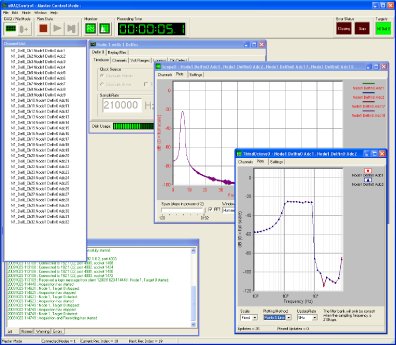
Typical Wind Tunnel

Graphical User Interface
Related Products
Skills Used
- Windows programming with Embarcadero C++
- Real time programming under Windows
- Use of Intel Performance Primitives
- VHDL design
- DSP
Commissioned to Develop
In 2009 we were commissioned by Aerodynamics and Aeromechanical Systems, at QinetiQ Farnborough to develop a 96 channel audio data recording and display system for their wind tunnel. Their wind tunnel was used for testing scaled down models of undercarriage components and systems.
The task was to replace an unsupported system with a bespoke system complete with 3rd Octave real time displays and million point FFT based post processing. The design aim was to enable real time display of large channel counts and greatly accelerate the post processing after each experiment. By reducing the post processing time the usage cycle of the facility could be improved, therefore adding value to their facility customer.
At the time, the suitable data acquisition card to base the system on was the Delfin. This has 32 channels of 24 bit 192ksps Adc’s that are sigma-delta type, ideal for audio because of their inherent linearity. We have since added support for many of the X3 family cards.
Distributed Acquisition and Storage
A distributed and network based topology was adopted to make the most of readily available PC based hardware.
The diagram above shows the basic system topology
Solution
Each data acquisition card was housed in its own industrial 2u PC (eDAQNode). It would stream its own data, 32 channels 24 bit at 192ksps ~ 25MB/s to its local HDD. Each node was controlled over the Gigabit Ethernet network from the User Control Program. The user can select any channel for display on the control PC in either the time or frequency domain. Frequency domain analysis is available using both Fast Fourier Transforms and Third Octave Filters. To minimise the network traffic, the transforms and filters were implemented on the Node processors and the results transferred across the network for display. Since the human eye can not perceive faster than about 30Hz, some results are running averaged before transport over the network. The architecture is scalable for larger channel count systems.
Faster Post Processing
It was an objective to reduce the post processing time for computing a high resolution spectrum of the entire dataset using multi million point FFT’s. The algorithm was calculated 100x faster by making careful use of Intel’s Performance Primitives for signal processing. This reduced a typical post process from 25 minutes to a few seconds.
System Spin-offs
The system software, known internally as eDAQ has been updated to support most of Innovative Integration’s newer data acquisition cards, including X3-10M, X3-SD, X3-SD16, X3-A4D4, X3-SDF, X3-2M, X3-25M. It can easily be modified to support other Innovative Adc boards.
